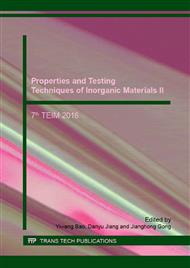p.33
p.38
p.43
p.50
p.55
p.60
p.65
p.70
p.75
Composition Analysis of an Unknown Redispersible Powder
Abstract:
As an important type of additive, the redispersible powder is widely applied in cement-based and gyp-based materials, so as to improve the cementing strength, impermeability, workability, hydrophobicity and so on. However, the chemical composition of the redispersible powders determines its applicability, as well as the degree of improvement to the matrix materials. In this paper, the chemical composition of an unknown redispersible powder was analyzed by several instruments. Firstly, Fourier transform infrared spectroscopy (FTIR) analysis indicated that the polymer was polymerized with monomers of vinyl esters. Secondly, pyrolysis-gas chromatography-mass spectrometry (Py-GC/MS) analysis showed the pyrolysis products were mainly acetic acid, methyl acetate and methyl versatates. Considering the pyrolysis mechanism of synthetic polymers and the results from FTIR spectra, the polymer in the redispersible powder was deduced to be the copolymer of vinyl acetate and vinyl ester of versatic acid (VeoVa), which was a monomer with a unique highly branched carbon-rich structure. Thermogravimetry (TG) analysis revealed that the powder contained 74.0% of polymer, 14.5% of calcium carbonate and 11.4% of other inorganic materials.
Info:
Periodical:
Pages:
55-59
Citation:
Online since:
January 2017
Authors:
Price:
Сopyright:
© 2017 Trans Tech Publications Ltd. All Rights Reserved
Share:
Citation:


